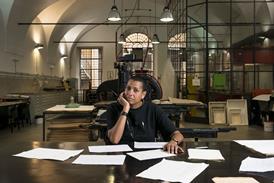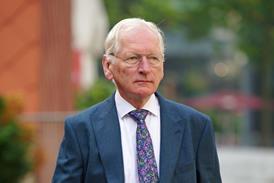Research at Chester Civil Court Centre indicates that the slow take-up of ADR is down to lawyers, not clients, write Derek Halbert and Clive Grant
'Agree with thine adversary quickly, whiles thou art in the way with him' - Matthew 5.25.
Late last year, there was a national mediation awareness week, with events in most courts promoting mediation in line with the Courts Service's strategic objective to 'reduce the proportion of disputes which are resolved by resort to the courts'.
At Chester Civil Justice Centre we have had a fully operational mediation scheme for over a year. It was developed in co-operation with local solicitors - the leading light was Brian Dawson of Walker Smith Way - and uses the Association of Northern Mediators to supply the qualified practitioners required. The scheme has been very successful with the cases referred to it. The up-to-date figures are:
The success rate for concluded cases is 11 out of 14, or 78.6%.
The advantages of a successful mediation are well known, at least among the legal profession. An additional factor which ought to lead cases towards mediation is that rule 1.4(e) of the Civil Procedure Rules (CPR) requires the court to encourage the parties to use an alternative dispute resolution (ADR) procedure if it considers that appropriate and to facilitate the use of such procedures.
The professional negligence pre-action protocol makes specific reference to ADR. Moreover, the Court of Appeal in Halsey v Milton Keynes General NHS Trust, Steel v Joy and another [2004] EWCA Civ 576 made it clear that in some circumstances the court will use CPR 44.3 to deprive a successful party of its costs if there is an unreasonable refusal to mediate.
There are other recent utterances in the Court of Appeal encouraging mediation - for example, Vahidi v Fairstead House School Trust Ltd (2005) The Times, 24 June and Al Khatib v Masry (2004) The Times, 21 October. Finally, solicitors with conduct of litigation are under a clear duty to consider ADR.
Despite these factors and despite considerable judicial encouragement in this area and the high success rate, the number of cases referred to mediation in the period of something over a year has been modest. In the 12 months to April 2005, the North Wales and Cheshire Group had 2,250 cases allocated to the multi and fast tracks, so the 16 cases referred to mediation represent a miniscule proportion. This raises the question of why the take up for such a successful scheme is not very much higher.
Two reasons suggest themselves. The first is public ignorance that the scheme exists; the second is that members of the legal profession see mediation as unnecessary, undesirable or even a threat to their fee income - and therefore, consciously or subconsciously, react against it when they advise clients.
To test the first possibility, during the week, a survey was conducted. It was not sophisticated. Members of the public present at the civil justice centre were simply asked to complete a single-page questionnaire with five questions:
The results represent a snapshot of those who must have been involved in some way in litigation, because this is the only reason why they would have been in the building. Some 82 questionnaires were completed, 14 by lawyers, which we have excluded these from the analysis. The following figures are based on the remaining 68. Forty-nine (72%) said they had heard of mediation and 39 said they knew how the process works; 39 (57%) also said they would be prepared to refer a dispute to mediation. The total number who said they would not have a dispute referred to mediation was only 12 (18%).
The results are admittedly on a small scale, but as far as they go they do not seem to support the hypothesis that public ignorance of the existence of mediation is the main or even a substantial cause of the low take-up - 57% of respondents were prepared to use mediation and 42% both knew what the process involves and said they would be prepared to use it.
That leaves legal reluctance as the likely cause. If this is because mediation is seen as a threat to fee income, the view is clearly misguided. Of course, if a case is settled by mediation at an early stage, the lawyer concerned will earn less from it, but he will have spent far less time on the matter and therefore can move quickly on to the next case. Provided there is a sufficient demand for the services of the lawyer concerned, the result of a high turnover of cases dealt with quickly is likely to be an increase in fee income. Whether there is a demand for the services of the lawyer will depend to a very substantial extent on the reputation of the lawyer concerned. The level of customer satisfaction is extremely important.
But customer satisfaction is likely to be very much higher if there is frequent resort to mediation. If a hypothetical average lawyer fights all his cases and wins half, his customer satisfaction rating is 50%. If a hypothetical second average lawyer mediates in all her cases and 70% of mediations succeed, she has 70% satisfied customers. If she then fights the remaining 30% and wins half, she has 85% satisfied customers.
This potential has been accepted by some leading practitioners. Amelans partner Martin Cockx, who acts almost entirely for claimants, writes: 'Mediation is actively encouraged within my practice. Put quite simply, mediation when properly approached works. It cuts down on risk both to the client and to the firm. It prevents having to put the client through the trauma of a trial. It enables outcomes which a court cannot order, such as an apology or an undertaking to change working practices or to repair defects... mediations succeed in over 70% of cases where they are used. How about that for reducing your risk?'
A corresponding view is expressed by leading defence lawyer Tony Gibbons, partner at Hill Dickinson, who says his firm considers mediation in all clinical negligence cases. 'Courts are now becoming interventionist and ordering that parties must consider whether mediation... can be productively used, a move that we welcome,' he says. 'Mediation gives a client the opportunity to be heard and for non-legal remedies to be proposed and discussed. It is often most beneficial in cases where there is an element of emotional overlay involved and in cases with particularly sensitive claimants.
'We have successfully mediated a number of clinical negligence cases, including the first group action mediation arising out of the Royal Liverpool Children's Litigation.'
It is clear that the courts do have power to force a mediation in appropriate circumstances. In Shirayama Shokusan Co Ltd v Danovo Ltd (2004) The Times, 22 March, [2003] EWHC 3006 Ch, it was held that the court does have power under CPR 1.1 to direct that the parties undertake ADR, even if one party is unwilling. However, this power is seldom used. Perhaps a more forceful approach by the courts would have better results.
Derek Halbert is Designated Civil Judge, North Wales and Cheshire; Clive Grant is court manager, Chester Civil Justice Centre, and an accredited mediator



























No comments yet